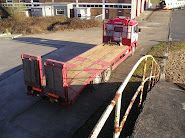Skiploaders.
These little machines are approx 1t capacity and are very narrow, two can usually be loaded side by side. They are automatic and usually hydraulic drive. One pedal on the floor, press down to go, lift to stop. Usually no handbrake either. Unladen weight is approx 1.5 - 2t
2t / 3t / 4t Dumpers.
Usually with a 3 speed manual gearbox and single reverse gear. Three pedals as per car but with vicious clutch, can easily lift the front wheels off the ground when empty if clutch raised too quickly. Unladen weight approx 2.5 -3t
5t / 6t/ 7t Dumpers
Usually with 3 pedals and 4 gears but with a torque converter so 4 forward / reverse gears. Otherwise as 3t dumpers but bigger chassis & skip. Unladen weight about 4.5t
9t / 10t Dumpers
Not that common, bigger version of a 6t dumper. Unladen approx 5.5t
Rear Tipping Dumpers
Hydrema & JCB most common of these, but again fairly rare. Full cab. Torque converter. Capacity 10-12t Unladen weight approx 8t. Really poor rearwards visibility means usually fitted with a rear view camera. Not very common. Bigger versions such as Volvo's, Terex & Bell 6 wheelers are out of my league and need transporting by lowloader.
Loading & Securing them.
Generally where they end up depends on what else is travelling with them, I usually back them on so it is easier to line them up. The smaller ones are light enough to sit up front if they are on their own and not overload the front axle.
I generally use 1 single chain over the centre swivel joint and clamp down tight if the dumper is in good condition with working brakes.
However if they are really knackered and the brakes are iffy I generally use two chains and use the front tie down eyes and the towpin. I carry a spare pin in the toolbox as these are invariably missing or a piece of bent rebar. This is the 'proper' way to secure them.
A final note on these is that they do not all have folding rollbars, they can stand very high when loaded so it's worth measuring to make sure of your height. And watch out for the beacon as they often get smashed. Skiploaders often have a beacon that has a bayonet fitting allowing it to be removed and stored under the seat.




1 comment:
Just a couple of points I want to make, firstly on the back on the teleported where you had the chain run through the eyes on the body and hook on the machine, this lets the machine move and can cause the eyes on the vehicle body to wear away as the chain rings chaff.. Also on the rear of the 3cx why would you chain through the back arm when there tie down points either side just in from the legs? And on the front arms you'd never chain over the arms surley??? My boss would sack me on the spot especially if I chaired over the rubber tracks of a 8ton machine, they should be through the carriage at least and u need 2 chains one pulling in each direction.. Generally some good advice but a little worried if anyone used this as a guide to safely loading machines.. These are quick and unprofessional ways to get by..
Post a Comment